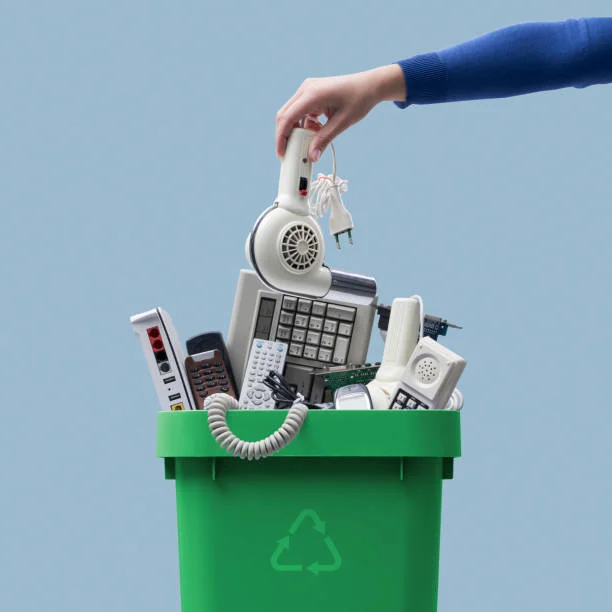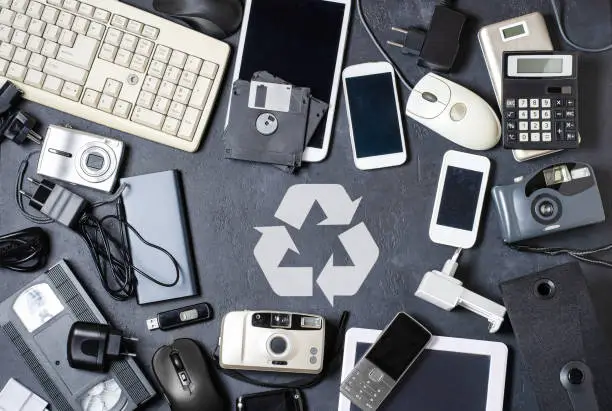Electronic waste, or e-waste, is the term used to describe discarded consumer electronics such as computers, mobile phones, TVs, and other electronics. These gadgets include components that, if improperly disposed of or recycled, might be detrimental to the environment.
Because of the increased usage of electronic gadgets and their short lifetime, e-waste is an issue that is spreading around the globe. Electronic gadgets that are not properly recycled or disposed of may unleash dangerous compounds including lead, mercury, and cadmium into the environment. These substances are a health concern to both people and animals and may pollute soil, water, and the air.
Several nations have put rules and regulations in place to promote the correct disposal and recycling of electronic equipment in order to solve the problem of e-waste. E-waste may be recycled to recover precious components that can be used to make new electronic gadgets, such as gold, silver, copper, and rare earth metals.
The lifetime of electronic equipment may be increased by maintenance and updates, old devices can be donated to charity or recycling facilities, and broken or unusable gadgets can be disposed of safely. E-waste management is essential since improperly disposed of electronics may have negative effects on the environment and human health.
Ways To Manage Electronic Waste (E-Waste) Properly

(1) Cut down on electrical waste
The best strategy to handle electronic trash is to decrease the quantity that is initially produced. This may be accomplished by selecting to purchase just the necessary amount of durable and repairable devices.
E-waste, often known as electronic garbage, is a global issue that is becoming worse. The quantity of electronic trash produced rises as technology develops and gadgets become more pervasive in our everyday lives. Here are some ideas for cutting down on technological waste:
Utilize your equipment as long as you can: Using your electronics as long as you can is one of the simplest strategies to decrease electrical waste. Try to keep using your gadgets until they stop working correctly rather than replacing them with the newest model every year or two.
Old gadgets may be donated or sold to someone who will use them. If you no longer need a device, think about doing one of these things. This may make the equipment last longer and prevent it from ending up in a landfill.
Recycle: Be careful to recycle your gadget after it is no longer functional. E-waste recycling programs are provided by several electronics stores and recycling facilities.
Purchase refurbished or used equipment: Instead of investing in a brand-new item, think about getting a refurbished or used one. This may help you save money and lessen the need for new technology.
Read Also: Domestic Waste Complete Management Guide
Avoid buying single-use gadgets: Single-use devices, such as disposable cameras and inexpensive headphones, are often not recyclable and add to e-waste.
Rechargeable batteries should be used in your gadgets to assist cut down on the amount of disposable batteries that are disposed of in landfills. You may limit the amount of electronic trash produced and encourage a more sustainable future by implementing these suggestions.
(2) Recycle old electrical equipment
Instead of tossing away your working electrical gadget, think about utilizing it again. You may either give it to someone in need or donate it to a charity. Reusing electronic equipment is a great method to cut down on electronic waste and lessen the effect of our consumption on the environment. Here are some ideas for recycling electrical equipment:
Donate or sell: If your old gadget is still functional, you may give it to a good cause or sell it to a person in need. You can also think about exchanging it for a more recent design.
Keep your old smartphone on hand as a backup in case your current one malfunctions or requires repair. You won’t need to purchase a new gadget immediately away if you do it this way. It may be used as a media center if you have an outdated laptop or desktop and connect it to your TV so you can stream movies, TV programs, and music.
Employ it for a specialized function: You may turn an outdated gadget into a dedicated gaming machine, an e-reader, or a digital picture frame.
Donate for educational purposes: If your old gadget is no longer functional for your requirements, schools or nonprofit groups may still find use for it. To find out whether your neighborhood’s schools, libraries, or community centers accept gifts of electronic equipment for education, get in touch with them. To preserve your privacy, always be sure to delete any personal data from your electronic devices before reusing them.
(3) Recycle your old electronics.
The environmental effect of electronic trash may be minimized with proper recycling. To dispose of your electronic equipment correctly, locate an area e-waste recycling facility. electronic garbage (e-waste) recycling is crucial for a number of reasons. Secondly, if not properly disposed of, hazardous substances like lead, mercury, and cadmium provide a danger to both human health and the environment.
Second, by containing precious metals and other elements that may be recovered and repurposed, e-waste can lessen the need for mining and the negative environmental effects associated with the extraction of new resources. The following actions may be taken to recycle your electronic waste:
To find out whether your local recycling program accepts e-waste, inquire with them. E-waste is accepted by several cities and municipalities via programs, either as part of curbside recycling or through specialized drop-off facilities.
Find a nearby e-waste recycling facility if your community’s recycling program does not accept electronic garbage. These facilities focus on the recycling and disposal of electronic equipment and can guarantee that it is done in an ecologically friendly way. Think about giving functional electronics to institutions, charities, or other groups that can utilize them.
Be careful to wipe the gadget clean before recycling or donating it if you need to get rid of a device that still has sensitive data on it. You may safely remove your data using third-party software or the data wiping features that are integrated into many devices. You can save natural resources and contribute to environmental protection by recycling your old electronics.
Read Also: Guide to Protected Areas Management
(4) Properly dispose of electronic trash
Take your electronic item to an authorized e-waste disposal facility if you are unable to recycle or reuse it. By doing this, you may prevent the electronic debris from being burned or thrown in a landfill, both of which can release hazardous chemicals into the environment.
(5) Encourage environmentally responsible manufacturing of electronics
Opt to purchase electronic equipment from companies who use eco-friendly manufacturing methods and assume responsibility for the end-of-life of their products. There are various ways that electronic manufacturers may embrace sustainable practices, including:
Sustainable sourcing: Electrical manufacturers may make sure that the resources they use to make their goods are environmentally friendly. Using eco-friendly, ethically sourced, and readily recyclable materials is a part of this.
Energy efficiency: Electronics producers should concentrate on creating devices that require less energy when in use. This may be done by integrating energy-saving features like power-saving modes, employing energy-efficient components, and improving product designs.
Recycling: Electronics producers may set up a scheme for recycling that will make sure their goods are disposed of appropriately after their useful lives. To reduce waste and pollution, this involves recycling parts and materials.
Packaging: By employing recyclable and biodegradable materials, lowering package size and weight, and getting rid of extra packaging, electronic makers may embrace sustainable packaging methods.
Minimize carbon footprint: By incorporating renewable energy sources like solar or wind power into their production processes, electronic manufacturers may lessen their carbon footprint.
Product lifespan: Electronic producers may create items that last longer, reducing the frequency with which they need to be replaced. This entails employing long-lasting, high-quality components, giving repair services, and providing updates to increase product longevity.
Transparency: By giving thorough details about their supply chain, production procedures, and product lifespan, electronic manufacturers may boost openness about their sustainability policies.
The environment and the manufacturers’ reputation may both gain from the use of sustainable manufacturing techniques. Electronics makers may decrease waste, preserve resources, and promote a cleaner, healthier environment by putting these strategies into effect.
(6) Raise consciousness
By instructing family, friends, and coworkers on how to handle electronic trash correctly, you may raise awareness of the significance of doing so and the effects it has on the environment. E-waste is the term used to describe electronic equipment and gadgets that have been abandoned or are no longer usable.
E-waste disposal mistakes may have detrimental effects on the environment and human health. Many electrical equipment contain dangerous substances like lead, mercury, and cadmium that may harm the environment by leaching into the soil and water. E-waste is also often dumped in landfills, where it might take hundreds of years for it to break down and release harmful chemicals into the atmosphere and soil.
These are some actions that people and organizations may do to raise awareness of electronic waste: Inform yourself and others on the risks of e-waste and the correct way to dispose of electronic equipment. Inform your friends, family, and coworkers about this information.
Reduce, reuse, and recycle: Buy just what you need when purchasing electronics to cut down on your usage. Use outdated electronics as little as possible and discard them at specialized e-waste recycling facilities.
Donate: Think about giving working electronics to educational institutions, nonprofits, or neighborhood associations.
Promote policy modifications: Promote regulations that support the safe and ethical disposal of e-waste. This might include supporting initiatives that provide incentives for recycling e-waste or advocating for legislation that forces manufacturers to accept returns of and recycle their goods.
Engage in community e-waste collection efforts, which are often put on by local governments or nonprofit groups. By following these actions, people and organizations may lessen the harm that e-waste does to the environment and to people’s health. These actions may assist handling electronic trash responsibly and lessen its negative effects on the environment.
Read Also: How to Easily Make the Most Classic Cocktails at Home

